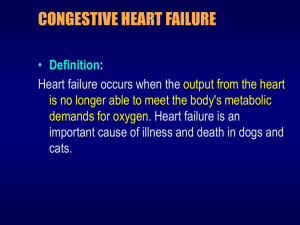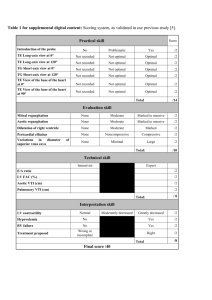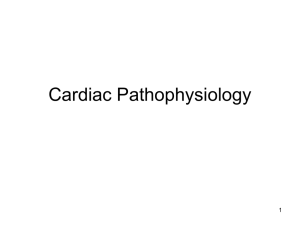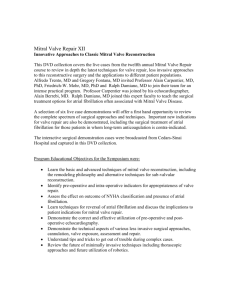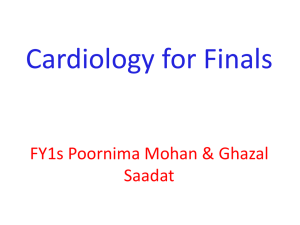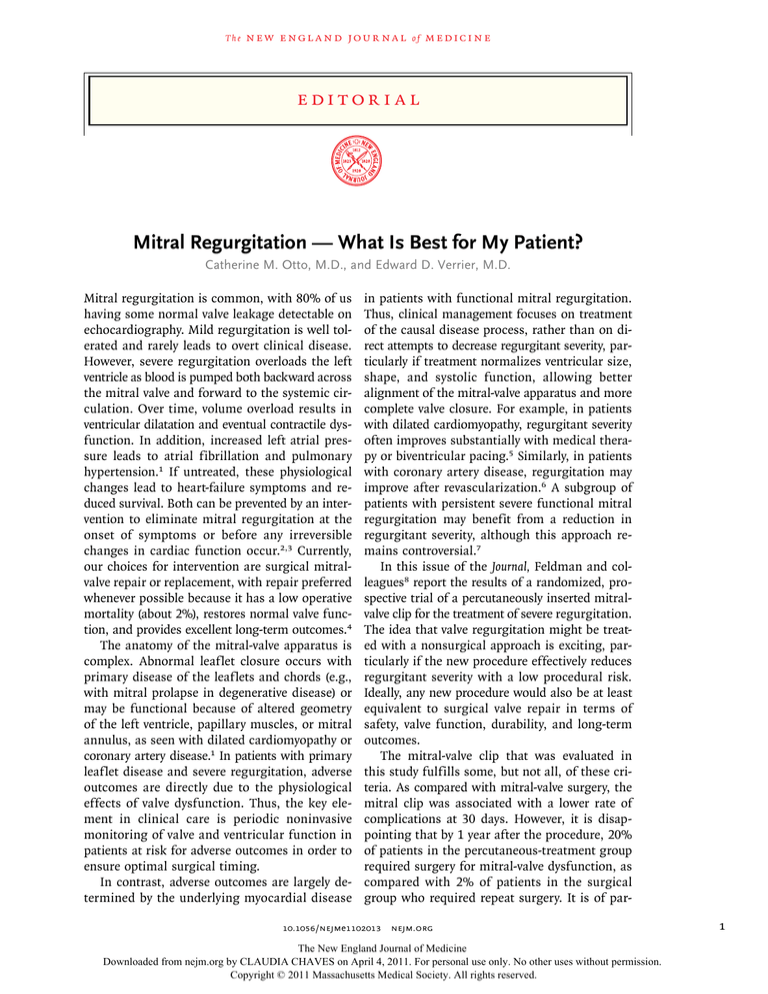
The
n e w e ng l a n d j o u r na l
of
m e dic i n e
edi t or i a l
Mitral Regurgitation — What Is Best for My Patient?
Catherine M. Otto, M.D., and Edward D. Verrier, M.D.
Mitral regurgitation is common, with 80% of us
having some normal valve leakage detectable on
echocardiography. Mild regurgitation is well tolerated and rarely leads to overt clinical disease.
However, severe regurgitation overloads the left
ventricle as blood is pumped both backward across
the mitral valve and forward to the systemic circulation. Over time, volume overload results in
ventricular dilatation and eventual contractile dysfunction. In addition, increased left atrial pressure leads to atrial fibrillation and pulmonary
hypertension.1 If untreated, these physiological
changes lead to heart-failure symptoms and reduced survival. Both can be prevented by an intervention to eliminate mitral regurgitation at the
onset of symptoms or before any irreversible
changes in cardiac function occur.2,3 Currently,
our choices for intervention are surgical mitralvalve repair or replacement, with repair preferred
whenever possible because it has a low operative
mortality (about 2%), restores normal valve function, and provides excellent long-term outcomes.4
The anatomy of the mitral-valve apparatus is
complex. Abnormal leaflet closure occurs with
primary disease of the leaflets and chords (e.g.,
with mitral prolapse in degenerative disease) or
may be functional because of altered geometry
of the left ventricle, papillary muscles, or mitral
annulus, as seen with dilated cardiomyopathy or
coronary artery disease.1 In patients with primary
leaflet disease and severe regurgitation, adverse
outcomes are directly due to the physiological
effects of valve dysfunction. Thus, the key element in clinical care is periodic noninvasive
monitoring of valve and ventricular function in
patients at risk for adverse outcomes in order to
ensure optimal surgical timing.
In contrast, adverse outcomes are largely determined by the underlying myocardial disease
in patients with functional mitral regurgitation.
Thus, clinical management focuses on treatment
of the causal disease process, rather than on direct attempts to decrease regurgitant severity, particularly if treatment normalizes ventricular size,
shape, and systolic function, allowing better
alignment of the mitral-valve apparatus and more
complete valve closure. For example, in patients
with dilated cardiomyopathy, regurgitant severity
often improves substantially with medical therapy or biventricular pacing.5 Similarly, in patients
with coronary artery disease, regurgitation may
improve after revascularization.6 A subgroup of
patients with persistent severe functional mitral
regurgitation may benefit from a reduction in
regurgitant severity, although this approach remains controversial.7
In this issue of the Journal, Feldman and colleagues8 report the results of a randomized, prospective trial of a percutaneously inserted mitralvalve clip for the treatment of severe regurgitation.
The idea that valve regurgitation might be treated with a nonsurgical approach is exciting, particularly if the new procedure effectively reduces
regurgitant severity with a low procedural risk.
Ideally, any new procedure would also be at least
equivalent to surgical valve repair in terms of
safety, valve function, durability, and long-term
outcomes.
The mitral-valve clip that was evaluated in
this study fulfills some, but not all, of these criteria. As compared with mitral-valve surgery, the
mitral clip was associated with a lower rate of
complications at 30 days. However, it is disappointing that by 1 year after the procedure, 20%
of patients in the percutaneous-treatment group
required surgery for mitral-valve dysfunction, as
compared with 2% of patients in the surgical
group who required repeat surgery. It is of par-
10.1056/nejme1102013 nejm.org
The New England Journal of Medicine
Downloaded from nejm.org by CLAUDIA CHAVES on April 4, 2011. For personal use only. No other uses without permission.
Copyright © 2011 Massachusetts Medical Society. All rights reserved.
1
editorial
ticular concern that substantial residual regurgitation (grade 2+ or more) was present in 46% of
patients in the percutaneous-treatment group,
as compared with 17% in the surgical group at
12 months. This modest reduction in regurgitant
severity might be associated with favorable
short-term and midterm outcomes, but surgical
series suggest that residual mitral regurgitation
predicts adverse long-term clinical outcomes.
This issue is further confused by the inclusion
of both patients with primary leaflet disease
and those with functional regurgitation; these
are different diseases with different clinical outcomes. Despite these concerns, the authors are to
be commended for performing a rigorous clinical trial with objective measures of valve and ventricular function, as well as clinical outcomes.
Regardless of whether the mitral clip becomes
part of our clinical toolkit, we will face some
difficult challenges in clinical decision making as
new minimally invasive devices become clinically
available during the next few years. The traditional
physician-directed approach to patient care has
worked well up to now, when only limited treatment options were available. Currently, the cardiologist most often decides when surgical intervention is appropriate and sends the patient on to
the cardiac surgeon. Although efficient, this approach breaks down as more options for intervention become available and the choices of watchful
waiting, medical therapy, percutaneous intervention, and surgical valve repair or replacement all
must be considered. This challenge is particularly
acute because valve disease is relatively uncommon, as compared with diseases such as coronary disease or heart failure, so that our guidelines are based on less compelling data and
individual physicians have less experience and
are less knowledgeable about valve disease.
To ensure that we do what is best for each
patient, we propose a patient-centered approach
to decision making in adults with valvular heart
disease. Instead of the traditional “consensus of
one,” we need a true consensus of experts with
review of each case by a multidisciplinary panel
that includes, at a minimum, a nonprocedural
valve-disease specialist, an interventional cardiologist, and a cardiac surgeon. The panel’s recommendation should be based on documentation of
2
severe valve dysfunction and indications for intervention, a patient-specific procedural risk assessment,9 expected anatomical and functional results, expected improvement in clinical symptoms
and quality of life, potential medication changes
(including anticoagulation), long-term outcome
data on survival and repeat procedures, and preferences of the patient.
Surgical correction of severe valve dysfunction
has provided dramatic improvements in clinical
outcomes of adults with valvular heart disease
during the past several decades. As we embrace
new approaches to mechanical correction of abnormal valve hemodynamics, we need to be sure
that we do not sacrifice proven long-term effectiveness for short-term issues, such as convenience, invasiveness, or reversible procedural complications. The goal is to make the patient feel
better and live longer.
Disclosure forms provided by the authors are available with
the full text of this article at NEJM.org.
From the Division of Cardiology, Department of Medicine
(C.M.O.), and the Division of Cardiothoracic Surgery, Department of Surgery (E.D.V.), University of Washington School of
Medicine, Seattle.
This article (10.1056/NEJMe1102013) was published on April 4,
2011, at NEJM.org.
1. Otto CM. Evaluation and management of chronic mitral re-
gurgitation. N Engl J Med 2001;345:740-6.
2. Enriquez-Sarano M, Avierinos J-F, Messika-Zeitoun D, et al.
Quantitative determinants of the outcome of asymptomatic mitral regurgitation. N Engl J Med 2005;352:875-83.
3. Rosenhek R, Rader F, Klaar U, et al. Outcome of watchful
waiting in asymptomatic severe mitral regurgitation. Circulation 2006;113:2238-44.
4. Suri RM, Schaff HV, Dearani JA, et al. Survival advantage
and improved durability of mitral repair for leaflet prolapse subsets in the current era. Ann Thorac Surg 2006;82:819-26.
5. Cleland JGF, Daubert J-C, Erdmann E, et al. The effect of
cardiac resynchronization on morbidity and mortality in heart
failure. N Engl J Med 2005;352:1539-49.
6. Mihaljevic T, Lam BK, Rajeswaran J, et al. Impact of mitral
valve annuloplasty combined with revascularization in patients
with functional ischemic mitral regurgitation. J Am Coll Cardiol
2007;49:2191-201.
7. Wu AH, Aaronson KD, Bolling SF, Pagani FD, Welch K, Koelling TM. Impact of mitral valve annuloplasty on mortality risk in
patients with mitral regurgitation and left ventricular systolic
dysfunction. J Am Coll Cardiol 2005;45:381-7.
8. Feldman T, Foster E, Glower DG, et al. Percutaneous repair
or surgery for mitral regurgitation. N Engl J Med 2011. DOI:
10.1056/NEJMoa1009355.
9. O’Brien SM, Shahian DM, Filardo G, et al. The Society of
Thoracic Surgeons 2008 cardiac surgery risk models. 2. Isolated
valve surgery. Ann Thorac Surg 2009;88:Suppl:S23-S42.
Copyright © 2011 Massachusetts Medical Society.
10.1056/nejme1102013 nejm.org
The New England Journal of Medicine
Downloaded from nejm.org by CLAUDIA CHAVES on April 4, 2011. For personal use only. No other uses without permission.
Copyright © 2011 Massachusetts Medical Society. All rights reserved.


